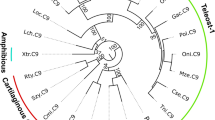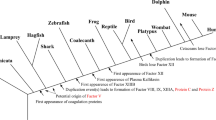Abstract.
We studied the evolutionary history of two homologous proteins of the human complement system, factor H (FH) and the α chain of the C4b binding protein (C4bpα), and included in this study the related proteins from the barred sand bass (P. nebulifer) and the nematode C. elegans. Phylogenetic trees inferred from individual short consensus repeats (SCRs) and divergence among repeats from different genes suggest that human FH has a much closer evolutionary relationship to putative complement components from P. nebulifer and C. elegans than does the C4bpα. This indicates that a member of the alternative pathway of the complement system (FH) has an ancient origin, while a homologous member of the classical pathway (C4bpα) appeared later in evolutionary history as a result of gene duplication. The ancient evolutionary position of FH is in agreement with the suggestion that the alternative pathway of the complement system is older than the classical pathway. Phylogenetic analysis also shows that the sand bass cofactor protein SBP1 and cofactor related protein SBCRP-1 have diverged very recently.
Similar content being viewed by others
Author information
Authors and Affiliations
Additional information
Received: 1 December 1997 / Accepted: 3 June 1998
Rights and permissions
About this article
Cite this article
Krushkal, J., Kemper, C. & Gigli, I. Ancient Origin of Human Complement Factor H. J Mol Evol 47, 625–630 (1998). https://doi.org/10.1007/PL00013152
Issue Date:
DOI: https://doi.org/10.1007/PL00013152




